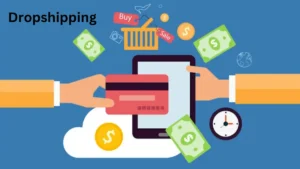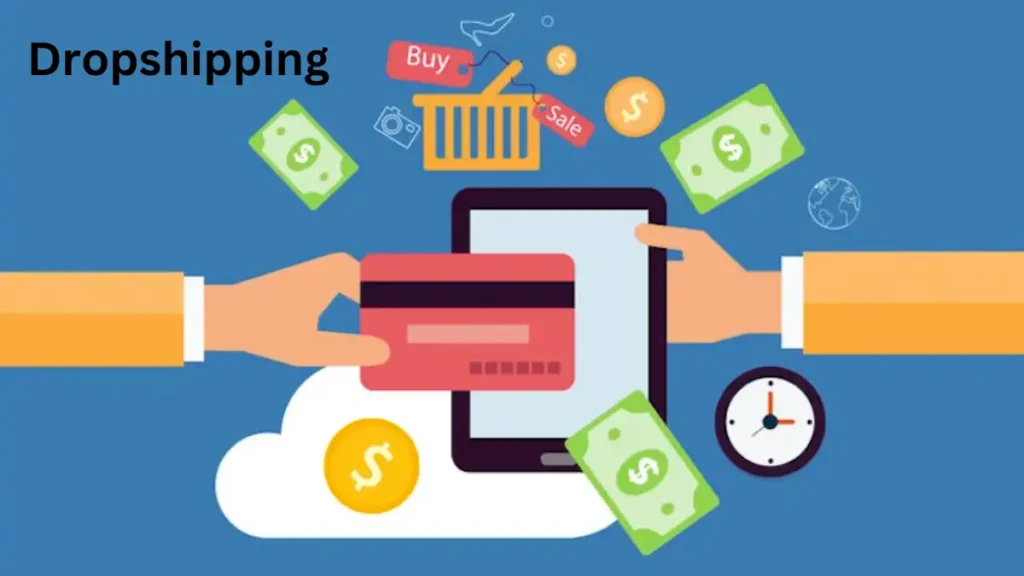Dropshipping is a popular e-commerce model that allows retailers to sell products without keeping inventory. In this setup, the retailer lists products in their online store, and when a customer makes a purchase, the order is fulfilled by a third-party supplier who ships the item directly to the customer. Dropshipping is attractive to entrepreneurs due to its low startup costs, flexible product selection, and ease of scalability.

Dropshipping tools and platforms that cover product sourcing, store setup, order management, and marketing:
| Tool Category | Tool/Website | Description |
| Product Sourcing | AliExpress |
A large online marketplace with suppliers offering a variety of products suitable for dropshipping.
|
| Oberlo |
A Shopify-integrated app that helps import and manage products from AliExpress.
|
|
| Spocket |
Focuses on high-quality suppliers from the U.S. and EU, offering faster shipping times.
|
|
| SaleHoo |
A directory of verified suppliers, helpful for finding trusted suppliers across various niches.
|
|
| Store Setup | Shopify |
An e-commerce platform with user-friendly tools for setting up a dropshipping store.
|
| WooCommerce |
A WordPress plugin that transforms a website into an online store with dropshipping functionality.
|
|
| BigCommerce |
An e-commerce platform with scalable options and dropshipping integration.
|
|
| Order Management | DSers |
An AliExpress dropshipping tool that simplifies order management and fulfillment.
|
| AutoDS |
Automates product listing, pricing, and order fulfillment across multiple platforms.
|
|
| Inventory Source |
Provides automated inventory syncing and order routing from suppliers.
|
|
| Marketing and SEO | Google Analytics |
Tracks visitor data and helps analyze traffic sources and customer behavior.
|
| SEMrush |
A comprehensive SEO tool that helps with keyword research, competitor analysis, and ranking tracking.
|
|
| Canva |
A graphic design tool for creating marketing materials, social media graphics, and ads.
|
|
| Mailchimp |
An email marketing tool for engaging with customers and sending promotions.
|
|
| Customer Support | Zendesk |
A customer service platform for managing inquiries and support tickets efficiently.
|
| Tidio |
A live chat solution that helps businesses communicate with customers in real-time.
|
|
| Gorgias |
An e-commerce helpdesk app, perfect for automating and managing customer support.
|
How Does Dropshipping Work?
Here’s how the process typically works:
- Product Listing: The retailer lists items on their website or platform without holding any physical inventory.
- Customer Purchase: A customer places an order for a product on the retailer’s website.
- Supplier Fulfillment: The retailer forwards the order to their supplier, who ships the product directly to the customer.
This inventory-free model has made dropshipping a go-to option for many new business owners, allowing them to focus on marketing and customer service rather than warehousing and logistics.
Read more: Boost SEO with Google Search Console: A Beginner’s Guide
Benefits of Dropshipping
1. Low Startup Costs: Without the need to purchase inventory upfront, entrepreneurs can start a dropshipping business with minimal investment.
2. No Inventory Management: Since suppliers handle storage and shipping, dropshippers avoid the costs and responsibilities associated with managing stock.
3. Scalability: Dropshipping allows for easy business scaling. Adding new products doesn’t require purchasing more inventory, so expanding a product line is straightforward.
4. Product Flexibility: Dropshippers can offer a wide range of products without committing to bulk inventory purchases. This enables quick adaptation to market trends and consumer preferences.
Challenges of Dropshipping
While dropshipping offers significant advantages, it comes with its own set of challenges:
1. Low Profit Margins: Because dropshipping is relatively low-risk, competition is high. This often drives prices down, impacting profit margins.
2. Limited Quality Control: Retailers rely on suppliers to ensure product quality and timely shipping. Issues in these areas can harm the retailer’s reputation.
3. High Competition: Low barriers to entry make it easy for others to start a dropshipping business, resulting in a highly competitive market.
4. Customer Service Management: Dropshippers must rely on suppliers for order fulfillment, which can lead to challenges in handling customer service issues, such as returns or delays.
Starting a Dropshipping Business: A Step-by-Step Guide
- Choose a Niche: Focusing on a niche market allows you to target a specific audience, making it easier to build a unique brand and reduce competition.
- Research Suppliers: Reliable suppliers are essential for successful drop shipping. Platforms like AliExpress, Oberlo, and Spocket offer a variety of supplier options. Evaluate suppliers based on product quality, shipping times, and reliability.
- Set Up Your Store: Use e-commerce platforms like Shopify or WooCommerce to create your online store. These platforms offer integrations with dropshipping apps that simplify product importing and order processing.
- Market Your Store: Effective marketing is crucial in dropshipping. Use SEO, social media marketing, and targeted ads to drive traffic to your store and attract potential customers.
- Manage Orders and Provide Customer Support: Since you control the customer experience, ensure smooth communication with customers and address any issues that arise, even if they’re supplier-related.
Dropshipping Made Easy: Step-by-Step Guide to Building Your E-commerce Store
| Step | Description |
| Choose Your Niche |
Focus on a specific market segment with proven demand.
|
| Find Reliable Suppliers |
Use platforms like Oberlo, AliExpress, and Spocket to source products.
|
| Set Up Your Store |
Choose Shopify or WooCommerce; customize with a professional template.
|
| Add Products |
Import products; optimize descriptions and images.
|
| Set Up Payment Gateways |
Use secure payment options like PayPal, Stripe, or Shopify Payments.
|
| Optimize for SEO |
Conduct keyword research; optimize titles, descriptions, and meta tags.
|
| Promote Your Store |
Utilize social media, paid ads, and influencer partnerships.
|
| Manage Orders |
Use inventory management software to streamline processes.
|
| Provide Customer Service |
Respond to inquiries promptly; handle complaints and returns professionally.
|
| Monitor Performance |
Track key metrics using analytics tools; refine strategies based on data insights.
|
Popular Dropshipping Platforms and Tools
Platforms like Shopify, BigCommerce, and WooCommerce make it easy to create an online store, while apps like Oberlo and Spocket streamline product sourcing and order fulfillment. Analytics tools like Google Analytics can also help track store performance and optimize for conversions.
| Platform/Tool | Purpose | Description |
| Shopify | Store Setup |
User-friendly e-commerce platform with extensive dropshipping integrations.
|
| WooCommerce | Store Setup |
WordPress plugin that transforms sites into customizable online stores with dropshipping options.
|
| AliExpress | Product Sourcing |
Global marketplace with a wide range of affordable products for dropshipping.
|
| Spocket | Product Sourcing |
Offers U.S. and EU-based suppliers for faster shipping and high-quality products.
|
| Oberlo | Product Importing |
Shopify app that simplifies importing products from AliExpress directly into your store.
|
| DSers | Order Management |
Automates bulk ordering and streamlines AliExpress dropshipping order fulfillment.
|
| Google Analytics | Marketing & Analytics |
Tracks store traffic, customer behavior, and conversion rates to help optimize performance.
|
| Zendesk | Customer Support |
Helps manage customer inquiries and support tickets for enhanced service efficiency.
|
Advertising and Social Media Influence Strategies for Dropshipping
- Targeted Social Media Ads: Use platforms like Facebook, Instagram, and TikTok to reach specific audiences through targeted ads based on demographics, interests, and behaviors.
- Influencer Partnerships: Collaborate with influencers in your niche to showcase products, leveraging their audience and credibility to boost brand exposure and trust.
- Retargeting Ads: Run retargeting campaigns to re-engage visitors who viewed products but didn’t purchase, using platforms like Google Ads and Facebook.
- User-Generated Content (UGC): Encourage customers to share their experiences with your products; reposting UGC on your channels enhances social proof and builds authenticity.
- Discounts and Giveaways: Run social media promotions with limited-time discounts or giveaways to drive engagement and attract new followers.
- Engage with Comments and DMs: Actively respond to messages and comments to build a positive relationship with your audience and increase engagement rates.
- Influencer Unboxing/Review Videos: Have influencers create unboxing or product review videos, which help demonstrate product quality and authenticity.
These strategies help create awareness, drive traffic, and establish credibility for your dropshipping store.
Best Practices for Dropshipping Success
To stand out in the competitive world of dropshipping, follow these best practices:
- Focus on Branding: A strong brand can create loyalty and set you apart from competitors.
- Provide excellent customer service: Respond quickly to customer inquiries and address any concerns proactively.
- Optimize for SEO and Organic Traffic: Invest in search engine optimization to drive organic traffic and reduce reliance on paid advertising.
- Adapt to Trends: Stay updated with market trends and be ready to adapt to customer preferences.
FAQs
Q: What is dropshipping and how does it work?
Dropshipping is a retail fulfillment method where a store doesn’t keep the products it sells in stock. Instead, when a store sells a product, it purchases the item from a third party and has it shipped directly to the customer. The retailer never sees or handles the product.
Q: What are the benefits of dropshipping?
The benefits of dropshipping include low startup costs, the ability to offer a wide range of products, no need for inventory management, and flexibility to operate from anywhere. It’s a great way to start an online business without significant financial risk.
Q: How do I find reliable suppliers for my dropshipping business?
Reliable suppliers can be found on platforms such as Oberlo, AliExpress, and Sprocket. It’s essential to research suppliers thoroughly, checking their ratings, reviews, and shipping times. Building strong relationships with suppliers and having backup options can also ensure reliability.
Q: What are the common challenges in dropshipping and how can I overcome them?
Common challenges include supplier reliability, long shipping times, and intense competition. Overcoming these challenges involves thorough supplier vetting, setting realistic customer expectations, providing excellent customer service, and finding a niche market to reduce competition.

